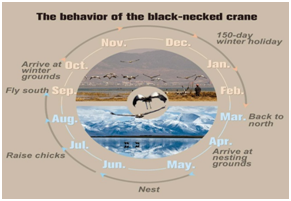

Context
Black-necked cranes (Grus nigricollis) native to the Tibetan plateau have been sighted for the first time in Assam.
About
What are Black-necked cranes?
- Black-necked cranes are iconic birds of the Tibetan Plateau, and are integral to the landscape’s biophysical ecosystem.
- They are of great spiritual and cultural significance to Tibetan Buddhism.
|
- These medium-sized alpine cranes, weighing about 5 kg each and standing about 115 cm tall, have a patch of red on their crowns, grey bodies and a characteristic black-neck.
- Habitat: Meadows are their favoured habitat, where they can feed on roots, insects, snails, fish, frogs, small birds and rodents.
- They breed exclusively in alpine meadows, at altitudes of 2,600 to 4,900 m, and as a protection from predators nest in marshes where the water is about 30 cm deep.
The world's only alpine crane species
- The black-necked crane is endemic to China's Tibetan Plateau.

- In summer, the black-necked cranes are mainly found in altitudes between 3,000 and 5,000 meters.
- The migration of the black-necked cranes starts in September via sheltered valleys or lower altitudes.
- About two thirds of the birds spend the winter in the valleys of Yarlung Tsangpo River and south-central Tibet Autonomous Region.
- The remaining population winter in Yunnan and Guizhou Provinces, and a small number are known to winter in Bhutan and
Conservation status
- These birds are threatened by human- and climate-change-induced habitat loss, and of late also by free-ranging dogs in their breeding areas and food shortage in wintering areas.
- It is now listed in Schedule I of Wildlife (Protection) Act 1972.
- In 2020, a re-assessment of the crane’s population led its status to change from Vulnerable to Near Threatened on the IUCN Red List.

